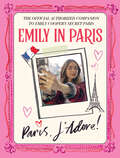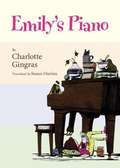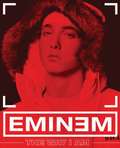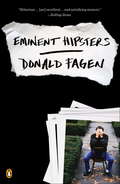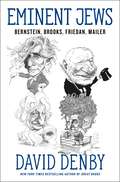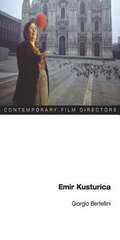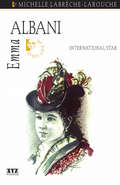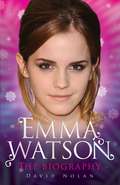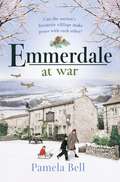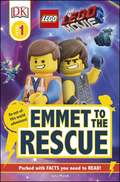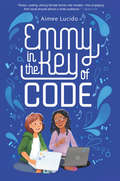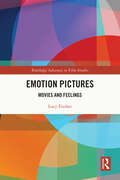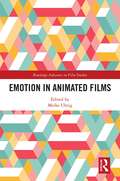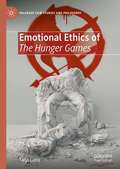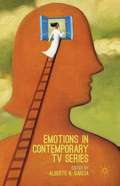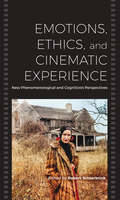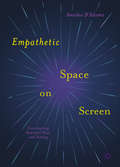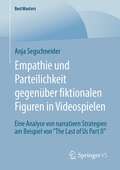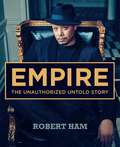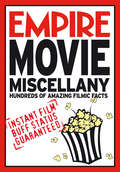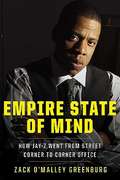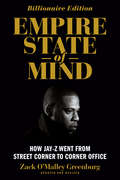- Table View
- List View
Emily in Paris: The Official Authorized Companion to Emily's Secret Paris
by Emily in ParisThe official authorized companion to the much-loved Netflix show Emily in Paris. Paris, J'Adore! is Emily Cooper's diary about her life in France so far. From leaving her boyfriend in Chicago to starting at marketing firm Savoir in Paris, it reveals all the thrill, fear and confusion Emily experiences as she embarks on her new life. She becomes acquainted not only with French workplace etiquette - the long lunches, the arguments, the determined reluctance to use social media - but also with Gabriel, the hottest chef in town. Some things, though, are beyond comprehension: like why the first floor in a Parisian apartment building is the second floor and the first floor is the ground floor. As the months go by, Emily learns how it's perfectly normal to have a glass of Sancerre for breakfast and how you should never turn up early at work. But more than anything, she learns about love, female friendships, and how exciting it is to step out of your comfort zone in this beautiful and intriguing city. Paris, J'Adore! is also a guidebook to how to be a Parisian, with tips on fashion, romance, and where to capture the perfect selfie in the City of Lights. Written in Emily's voice, it will contain the following sections: Emily's Fashion Paris - all about Emily's favourite outfits and designers - from Cadault to Chanel - as well as tips on what to wear to the beach, where to find the best boutiques, and how to dress like a Parisian; Emily's Romantic Paris - the best bridges to kiss and break up on, where you can find the most breathtaking views and the most perfect backstreets, why the magic of the Eiffel Tower twinkling at night is the most intoxicating backdrop to falling in love, and a selection of the most evocative French songs to sing along to; Emily's Secret Paris - where Parisians show Emily the real Paris, from the hamman in the Mosquée de Paris to the Atelier des Lumières, and from small independent French cinemas to delightful neighbourhood restaurants; Emily's Workplace Paris - how to navigate tensions and emotions in a French boardroom, lunch and coffee break rituals, Sylvie's own version of Savoir's Employee Handbook, and how to teach the French about social media; Emily's Escapades from Paris - including the delights of the Champagne region, the sheer glamour of Saint-Tropez and the opulence of the Château de Versailles. Packed with four-colour photographs, exquisite illustrations and beautiful shots of Paris, Paris, J'Adore! is a hugely desirable gift book for all the fans of the show.
Emily's Piano
by Charlotte GingrasAn honest portrayal of a young girl's emotional journey amid family upheavals. Nine-year-old Emily is trying to cope with her changing world. When her father and mother grow further apart, the family's piano -- Emily's link to the good times that once flooded her home -- is sold. She decides the key to the happiness her family used to share is the piano, and so she must find it. Believing the instrument is most likely in a part of town where rich people live, Emily sets out on her search. She knocks on many doors without success, but carries on, determined to end the darkness that has descended on her home. Finally a piano teacher gives her a lead. Though the days pass slowly, she eventually receives the anticipated call. "Be there Sunday at 1 p.m. sharp," she's told. It turns out the piano is now in a convent, where it sits in the middle of a room, like royalty. Sister Isabelle tells Emily she can come by any Sunday, and she can bring her mother too. The first time Emily's mother sees the piano, she plays, sings, and cries. The darkness in their lives slowly tiptoes away as Emily and her mother rediscover happiness and the healing power music brings.
Eminem: The Way I Am
by Eminem Sacha JenkinsFor the first time, one of music's most popular--and headline-making--rap artists shares his private reflections, drawings, handwritten lyrics, and never-before-seen photographs. Fiercely intelligent, relentlessly provocative, and prodigiously gifted, Eminem is known as much for his enigmatic persona as for being the fastest-selling rap artist and the first rapper to ever win an Oscar. Now, in The Way I Am, he shares his private thoughts on everything from his inner struggles, to the trials of being famous, to his love for his daughter, Hailie, creating a book that is every bit as raw and uncensored as the man himself. Illustrated with never-before-seen photographs of Eminem's home and life along with original drawings, The Way I Amis filled with reflections on his greatest hits, previously unpublished lyric sheets, and other rare memorabilia. Providing his millions of fans with a personal tour of Eminem's creative process, it is poised to be hailed in much the same way as Tupac's The Rose that Grew from Concrete, Bob Dylan's Chronicles, and Journals by Kurt Cobain.
Eminent Hipsters
by Donald FagenIn Eminent Hipsters, musician and songwriter Donald Fagen, best known as the co-founder of the rock band Steely Dan, presents an autobiographical portrait that touches on everything from the cultural figures that mattered the most to him as a teenager, to his years in the late 1960s at Bard College, to a hilarious account of a recent tour he made with Boz Scaggs and Michael McDonald. Fagen begins by introducing the 'eminent hipsters' that spoke to him as he was growing up (and desperately yearning to be hip) in suburban New Jersey in the late 1950s and early 1960s. The figures who influenced him most were not the typical ones - Miles Davis, say, or Jack Kerouac - but rather people like Jean Shepherd, whose manic, acidic nightly radio broadcasts out of WOR-Radio had a tough realism about life and 'enthralled a generation of alienated young people'; Henry Mancini, whose chilled-out, nourish soundtracks, especially to films by Blake Edwards utilised the unconventional, spare instrumentation associated with the cool jazz school; and Mort Fega, the laid back, knowledgeable all night jazz man at WEVD, who was like 'the cool uncle you always wished you had'. He writes of how, growing up as a Cold War baby, one of his primary doors of escape became reading science fiction by such authors as Philip K. Dick, and of his regular trips into New York City to hear jazz. Other emblematic musical heroes Fagen writes about include Ray Charles, Ike Turner, and the Boswell Sisters, a trio from the 1920s and 30s whose subversive musical genius included trick phrasing and way out harmony. 'Class of '69' recounts Fagen's colourful tumultuous years at Bard College, the progressive university north of New York City that attracted a strange mix of applicants, including 'desperate suburban misfits with impressive verbal skills but appalling high school records' (like himself). It was at Bard that Fagen first met Walter Becker, with whom he would later form Steely Dan. The final section of the book, 'With the Dukes of September', offers a day-by-day account of a tour Fagen undertook last summer across America with Boz Scaggs and Michael McDonald, performing a programme of old R&B and soul tunes as well as some of each of their own hits. Told in a weary, cranky, occasionally biting and always entertaining voice, Fagen brings to life the ups and downs and various indignities and anxieties of being on the road - The Dukes were an admittedly 'low-rent operation' compared to a Steely Dan tour - as well as communicating the challenges and joy of playing every night to a different crowd in a different city.
Eminent Jews: Bernstein, Brooks, Friedan, Mailer
by David DenbyLeonard Bernstein, Mel Brooks, Betty Friedan, and Norman Mailer. Brilliant, brash, yet soulful, they were 100 percent Jewish and 100 percent American. They upended the restrained culture of their forebears and changed American life.They worked in different fields, and, apart from clinking glasses at parties now and then, they hardly knew one another. But they shared a historical moment and a common temperament. For all four, their Jewish heritage was electrified by American liberty. The results were explosive.As prosperity for Jews increased and anti-Semitism began to fade after World War II, these four creative giants stormed through the latter half of the twentieth century, altering the way people around the world listened to music, defined what was vulgar, comprehended the relations of men and women, and understood the American soul. They were not saints; they were turbulent and self-dissatisfied intellectuals who fearlessly wielded their own newly won freedom to charge up American culture.Celebratory yet candid, at times fiercely critical, David Denby presents these four figures as egotistical and generous—larger-than-life, all of them, yet vulnerable, even heartbreaking, in their ambition, ferocity, and pride.
Emir Kusturica (Contemporary Film Directors)
by Giorgio BertelliniEmir Kusturica is one of Eastern Europe's most celebrated and influential filmmakers. Over the course of a thirty-year career, Kusturica has navigated a series of geopolitical fault lines to produce subversive, playful, often satiric works. On the way he won acclaim and widespread popularity while showing a genius for adjusting his poetic pitch--shifting from romantic realist to controversial satirist to sentimental jester. Leading scholar-critic Giorgio Bertellini divides Kusturica's career into three stages--dissention, disconnection, and dissonance--to reflect both the historic and cultural changes going on around him and the changes his cinema has undergone. He uses Kusturica's Palme d'Or winning Underground (1995)--the famously inflammatory take on Yugoslav history after World War II--as the pivot between the tone of romantic, yet pungent critique of the director's early works and later journeys into Balkanist farce marked by slapstick and a self-conscious primitivism. Eschewing the one-sided polemics Kusturica's work often provokes, Bertellini employs balanced discussion and critical analysis to offer a fascinating and up-to-date consideration of a major figure in world cinema.
Emma Albani: Victorian Diva (The Quest Library)
by Darcy Dunton Michelle Labrèche-LaroucheBorn in Quebec, Emma Lajeunesse studied in Europe and in 1869 at the age of 23 launched her opera career in Italy. Almost overnight she became Albani, the world-renowned diva.
Emma Watson: The Biography
by David NolanDavid Nolan provides a detailed insight into Emma Watson's career, the highs and lows of being a child star and how she is moving on from Harry Potter balancing the world of fashion with her academic studies in America.
Emma's Turn (No Way Ballet #3)
by Suzanne WeynLost at Lincoln Center? Emma Guthrie never wanted to leave New York City and move to Eastbridge. Even though she has two good friends, Charlie and Lindsey, in her ballet class at Miss Claudine's, she misses the city and her friend Kerry. When Miss Claudine's class visits the city to see the Nutcracker Suite ballet, Emma makes plans to meet Kerry. But the reunion doesn't work out as expected-and a disappointed Emma decides she's not going to the ballet performance. Now it's up to Charlie and Lindsey to follow her and save the day. But in doing that, all three girls are in for more adventure-and more ballet-than the rest of the class.
Emmerdale at War: an uplifting and romantic read perfect for nights in (Emmerdale, Book 3)
by Pamela BellThe perfect Christmas gift full of warmth and nostalgia, for fans of ITV's Emmerdale, and readers who love heartwarming and heartbreaking stories set during World War II.Britain is at war once again and the families of Emmerdale are trying their best to cope with a new way of life.Rationing has been introduced across the country, two million more men have been called up for service, and blackouts, evacuees and military training camps have become the norm. In Beckindale, three young women are about to find their lives changed forever...Annie Pearson is working on Emmerdale Farm, while her love, Edward Sugden is at the front line. Lily Dingle has found purpose in joining the ATS, though she may get more than she bargained for. And Meg Warcup, now teaching at the local school, has taken in two children evacuated from Hull. They've adjusted to their new way of life until one day a German plane comes crashing down in the village... and changes everything in the village of Beckindale.The third novel in the Emmerdale series transports us to the Yorkshire Dales in the midst of World War II, exploring the lives of Emmerdale's much-loved families. Will the nation's favourite village overcome adversity to deal with the loves and lives lost?
Emmerdale at War: an uplifting and romantic read perfect for nights in (Emmerdale, Book 3) (Emmerdale)
by Pamela BellThe perfect Christmas gift full of warmth and nostalgia, for fans of ITV's Emmerdale, and readers who love heartwarming and heartbreaking stories set during World War II.Britain is at war once again and the families of Emmerdale are trying their best to cope with a new way of life.Rationing has been introduced across the country, two million more men have been called up for service, and blackouts, evacuees and military training camps have become the norm. In Beckindale, three young women are about to find their lives changed forever...Annie Pearson is working on Emmerdale Farm, while her love, Edward Sugden is at the front line. Lily Dingle has found purpose in joining the ATS, though she may get more than she bargained for. And Meg Warcup, now teaching at the local school, has taken in two children evacuated from Hull. They've adjusted to their new way of life until one day a German plane comes crashing down in the village... and changes everything in the village of Beckindale.The third novel in the Emmerdale series transports us to the Yorkshire Dales in the midst of World War II, exploring the lives of Emmerdale's much-loved families. Will the nation's favourite village overcome adversity to deal with the loves and lives lost?
Emmet to the Rescue (DK Readers #Level 1)
by Julia MarchBlast off with Emmet on an epic mission! <p><p> Help him search for his missing friends. Meet Rex the space pilot. Can Rex help Emmet travel through space to find his friends? <p> Engaging topics and fun, interactive pages build reading skills in this Level 1 Reader - just right for children who are learning to read. A fun quiz at the end of the book helps to develop reading comprehension skills. Each title in the DK Readers series is developed in consultation with leading literacy experts to help children build a lifelong love of reading.
Emmy in the Key of Code
by Aimee LucidoIn this innovative middle grade novel, coding and music take center stage as new girl Emmy tries to find her place in a new school. Perfect for fans of GIRLS WHO CODE series and THE CROSSOVER.In a new city, at a new school, twelve-year-old Emmy has never felt more out of tune. Things start to look up when she takes her first coding class, unexpectedly connecting with the material—and Abigail, a new friend—through a shared language: music. But when Emmy gets bad news about their computer teacher, and finds out Abigail isn’t being entirely honest about their friendship, she feels like her new life is screeching to a halt. Despite these obstacles, Emmy is determined to prove one thing: that, for the first time ever, she isn’t a wrong note, but a musician in the world's most beautiful symphony.
Emotion Pictures: Movies and Feelings (Routledge Advances in Film Studies)
by Lucy FischerThis book investigates a group of exceptional films that single-mindedly consider one particular emotion – be it pity, lust, grief, or anxiety – to examine cinematic emotion in depth. Drawing on philosophical and psychological approaches, Fischer’s unique analysis offers unparalleled case studies for comprehending emotion in the movies. The book provides the reader with an opportunity to contemplate what notion of a particular emotion is advanced onscreen; to describe how the unique tools and aesthetics of cinema are utilized to do so; to place such representations in dialogue with film theory as well as philosophical and psychological commentary; and to illustrate the important dichotomy between filmic portrayals and audience response. Beyond film and media scholars and students, this book will have resonance for academics and practitioners in several fields of psychology, including social work, psychiatry, and therapy.
Emotion in Animated Films (Routledge Advances in Film Studies)
by Meike UhrigRanging from blockbuster movies to experimental shorts or documentaries to scientific research, computer animation shapes a great part of media communication processes today. Be it the portrayal of emotional characters in moving films or the creation of controllable emotional stimuli in scientific contexts, computer animation’s characteristic artificiality makes it ideal for various areas connected to the emotional: with the ability to move beyond the constraints of the empirical "real world," animation allows for an immense freedom. This book looks at international film productions using animation techniques to display and/or to elicit emotions, with a special attention to the aesthetics, characters and stories of these films, and to the challenges and benefits of using computer techniques for these purposes.
Emotional Ethics of The Hunger Games (Palgrave Film Studies and Philosophy)
by Tarja LaineEmotional Ethics of The Hunger Games expands the ‘ethical turn’ in Film Studies by analysing emotions as a source of ethical knowledge in The Hunger Games films. It argues that emotions, incorporated in the thematic and aesthetic organization of these films, reflect a crisis in moral standards. As such they cultivate ethical attitudes towards such phenomena as totalitarianism, the culture of reality television, and the society of spectacle. The focus of the argument is on cinematic aesthetics, which expresses emotions in a way that highlights their ethical significance, running the gamut from fear through guilt and shame, to love, anger and contempt. The central claim of the book is that these emotions are symptomatic of some moral conflict, which renders The Hunger Games franchise a meaningful commentary on the affective practice of cinematic ethics. ‘’The Hunger Games movies have become iconic symbols for resistance across the globe. Tarja Laine proposes that this is not caused by their status as exciting cinematic spectacles, but by their engaging our emotions. Laine uses The Hunger Games as key texts for understanding our world, demonstrating that ethics do not originate from rational considerations, far removed from those mucky things called emotions. But rather that emotions are at the core of cinematic ethics.”—William Brown, Author of Supercinema: Film-Philosophy for the Digital Age ‘’In this elegantly written exploration of the relationship between aesthetics and emotion in The Hunger Gamestrilogy, Tarja Laine illuminates the power of film to embody ethical conflict. Deftly interweaving film-philosophy and close analysis, Laine traces how these films mobilise complex emotions, nuancing our thinking about cinema and the spectator. Laine’s book takes The Hunger Games films seriously, demonstrating with verve why they matter.”—Catherine Wheatley, Senior Lecturer in Film Studies, King’s College London, UK ''In this fresh, engaging, and insightful study of The Hunger Games film trilogy, Tarja Laine explores the crucial role that emotions play in appreciation of the ethical qualities of the movies. She forges productive dialogues between a range of film theory, scholarship on moral philosophy, and debates on ethics, as she performs a multi-layered investigation of the aesthetic qualities of the trilogy, the multiple emotions embodied in these qualities, and the philosophical-ethical insights that are in turn embedded in these emotions. The cinematic connection between emotions and ethics that emerges through Laine’s detailed textual analyses confronts us with complex moral dilemmas while enriching our aesthetic experience.'' —Sarah Cooper, Professor, Film Studies Department, King's College London, UK
Emotions in Contemporary TV Series
by Alberto Garc�aThis edited collection offers a wide range of essays showcasing current research on emotions in TV series. The chapters develop from a variety of research traditions in film, television and media studies and explores American, British, Nordic and Spanish TV series.
Emotions, Ethics, and Cinematic Experience: New Phenomenological and Cognitivist Perspectives
by Robert SinnerbrinkSince the early 1990s, phenomenology and cognitivism have become two of the most influential approaches to film theory. Yet far from being at odds with each other, both approaches offer important insights on our subjective experience of cinema. Emotions, Ethics, and Cinematic Experience explores how these two approaches might work together to create a philosophy of film that is both descriptively rich and theoretically productive by addressing the key relationship between cinematic experience, emotions, and ethics.
Empathetic Space on Screen
by Amedeo D'AdamoIn this book we learn that there is a clear but complex relationship between setting and character on screen. Certain settings stand out above others—think of the iconic gooey dripping tunnels that Ripley stumbles through in Aliens, Norman’s bird-decorated parlour in Psycho or the dark Gotham of certain Batman movies. But what makes these particular settings so powerful and iconic? Amedeo D’Adamo explains why we care about and cry for certain characters, and then focuses on how certain places then become windows onto their emotional lives. Using popular case studies such as Apocalypse Now, Amelie, Homeland and The Secret Garden, this original and insightful book is the first to really explain what makes some settings so effective, revealing an important but as yet uncovered machinery of empathy in visual narrative space. An invaluable resource for students, academics and indeed young filmmakers designing their very own narratives for space on screen.
Empathie und Parteilichkeit gegenüber fiktionalen Figuren in Videospielen: Eine Analyse von narrativen Strategien am Beispiel von “The Last of Us Part II” (BestMasters)
by Anja SegschneiderWie entstehen Empathie und Parteilichkeit in interaktiven Medien? Ausgehend von der These, dass interaktive Medien wie Videospiele eher dazu in der Lage sind, Empathie und Parteilichkeit zu erzeugen als lineare Medien, geht die Arbeit dieser Frage nach. Als Beispiel dient das populäre Survival-Horror-Spiel „The Last of Us Part II“ aus dem Jahr 2020. Das theoretische Fundament bilden bestehende Theorien aus Film- und Medienwissenschaft sowie der Psychologie, die auf das interaktive Medium übertragen und angepasst werden. Ein Fokus liegt auf narrativen und ludonarrativen Strategien. Dabei schlägt die Arbeit auch einen Bogen zu gesamtgesellschaftlichen Trends in den Medien und analysiert, inwiefern die Strategien für Parteilichkeit und Empathie in interaktiven Medien einen nachhaltigen Einfluss in der realen Welt entfalten können.
Empire
by Robert HamAn unofficial guide to EMPIRE, the runaway hit of the 2014-15 television season.Empire is the breakout, network television hit of 2015--from its opening night, viewers were riveted by the story of record company magnate Lucious Lyon and his family, and the struggle for control over Empire Entertainment. As the second season approaches this September, Empire: The Unauthorized Untold Story tells you everything you need to know about this powerful drama. You'll get full backgrounds on all the major players, including the real-life entertainment icons on whom their stories are based. You'll learn about the music and fashions that helped drive the show's success. And you'll get a hint of what the second season might hold as show creators Lee Daniels and Danny Strong prepare to build on their phenomenal opening act.
Empire Films and the Crisis of Colonialism, 1946–1959
by Jon CowansThe first transnational history of cinema’s role in decolonization.Using popular cinema from the United States, Britain, and France, Empire Films and the Crisis of Colonialism, 1946–1959, examines postwar Western attitudes toward colonialism and race relations. Historians have written much about the high politics of decolonization but little about what ordinary citizens thought about losing their empires. Popular cinema provided the main source of images of the colonies, and, according to Jon Cowans in this far-reaching book, films depicting the excesses of empire helped Westerners come to terms with decolonization and even promoted the dismantling of colonialism around the globe.Examining more than one hundred British, French, and American films from the post–World War II era, Cowans concentrates on movies that depict interactions between white colonizers and nonwhite colonial subjects, including sexual and romantic relations. Although certain conservative films eagerly supported colonialism, Cowans argues that the more numerous "liberal colonialist" productions undermined support for key aspects of colonial rule, while a few more provocative films openly favored anticolonial movements and urged "internal decolonization" for people of color in Britain, France, and the United States.Combining new archival research on the films’ production with sharp analysis of their imagery and political messages, the book also assesses their reception through box-office figures and newspaper reviews. It examines both high-profile and lesser-known films on overseas colonialism, including The King and I, Bhowani Junction, and Island in the Sun, and tackles treatments of miscegenation and "internal colonialism" that appeared in Westerns and American films like Pinky and Giant. The first truly transnational history of cinema’s role in decolonization, this powerful book weaves a unified historical narrative out of the experiences of three colonial powers in diverse geographic settings.
Empire Movie Miscellany: Instant Film Buff Status Guaranteed
by Empire MagazineFrom the team who brought you The Empire Film Guide, here are all the obscure, indecent and downright bizarre movie facts and figures that were not considered sensible for a practical film guide. Discover which country translated GI Jane as Satan Female Soldier, which Hollywood heartthrob is the lead singer of 30 Odd Foot of Grunts, and which country takes a bag of toasted leaf cutter ants to the cinema instead of popcorn! The Schott's Miscellany of movies, packed full of movie facts, figures and lists, as well as explanations of filmmaking terminology and a "shot miscellany" - a list of all the various camera shots. You will soon know your Oscar Hosts from your Monty Python French insults, and never be short of small talk again!
Empire State of Mind
by Greenburg Zack O'Malley"I'm not a businessman-I'm a business, man. " --Jay-Z Some people think Jay-Z is just another rapper. Others see him as just another celebrity/mega-star. The reality is, no matter what you think Jay-Z is, he first and foremost a business. And as much as Martha Stewart or Oprah, he has turned himself into a lifestyle. You can wake up to the local radio station playing Jay-Z's latest hit, spritz yourself with his 9IX cologne, slip on a pair of his Rocawear jeans, lace up your Reebok S. Carter sneakers, catch a Nets basketball game in the afternoon, and grab dinner at The Spotted Pig before heading to an evening performance of the Jay-Z-backed Broadway musical Fela! and a nightcap at his 40/40 Club. He'll profit at every turn of your day. But despite Jay-Z's success, there are still many Americans whose impressions of him are foggy, outdated, or downright incorrect. Surprisingly to many, he honed his business philosophy not at a fancy B school, but on the streets of Brooklyn, New York and beyond as a drug dealer in the 1980s. Empire State of Mind tells the story behind Jay-Z's rise to the top as told by the people who lived it with him- from classmates at Brooklyn's George Westinghouse High School; to the childhood friend who got him into the drug trade; to the DJ who convinced him to stop dealing and focus on music. This audio book explains just how Jay-Z propelled himself from the bleak streets of Brooklyn to the heights of the business world. Zack O'Malley Greenburg draws on his one-on-one interviews with hip-hop luminaries such as DJ Clark Kent, Questlove of The Roots, Damon Dash, Fred "Fab 5 Freddy" Brathwaite, MC Serch; NBA stars Jamal Crawford and Sebastian Telfair; and recording industry executives including Craig Kallman, CEO of Atlantic Records. He also includes new information on Jay-Z's various business dealings, such as: * The feature movie about Jay-Z and his first basketball team that was filmed by Fab 5 Freddy in 2003 but never released. * The Jay-Z branded Jeep that was scrapped just before going into production. * The real story behind his association with Armand de Brignac champagne. * The financial ramifications of his marriage to Beyonce. Jay-Z's tale is compelling not just because of his celebrity, but because it embodies the rags-to-riches American dream and is a model for any entrepreneur looking to build a commercial empire.
Empire State of Mind: How Jay Z Went from Street Corner to Corner Office, Revised Edition
by Steve Forbes Zack O'Malley Greenburg"I'm not a businessman-I'm a business, man." --Jay-Z Some people think Jay-Z is just another rapper. Others see him as just another celebrity/mega-star. The reality is, no matter what you think Jay-Z is, he first and foremost a business. And as much as Martha Stewart or Oprah, he has turned himself into a lifestyle. You can wake up to the local radio station playing Jay-Z's latest hit, spritz yourself with his 9IX cologne, slip on a pair of his Rocawear jeans, lace up your Reebok S. Carter sneakers, catch a Nets basketball game in the afternoon, and grab dinner at The Spotted Pig before heading to an evening performance of the Jay-Z-backed Broadway musical Fela! and a nightcap at his 40/40 Club. He'll profit at every turn of your day. But despite Jay-Z's success, there are still many Americans whose impressions of him are foggy, outdated, or downright incorrect. Surprisingly to many, he honed his business philosophy not at a fancy B school, but on the streets of Brooklyn, New York and beyond as a drug dealer in the 1980s. Empire State of Mind tells the story behind Jay-Z's rise to the top as told by the people who lived it with him- from classmates at Brooklyn's George Westinghouse High School; to the childhood friend who got him into the drug trade; to the DJ who convinced him to stop dealing and focus on music. This book explains just how Jay-Z propelled himself from the bleak streets of Brooklyn to the heights of the business world. Zack O'Malley Greenburg draws on his one-on-one interviews with hip-hop luminaries such as DJ Clark Kent, Questlove of The Roots, Damon Dash, Fred "Fab 5 Freddy" Brathwaite, MC Serch; NBA stars Jamal Crawford and Sebastian Telfair; and recording industry executives including Craig Kallman, CEO of Atlantic Records. He also includes new information on Jay-Z's various business dealings, such as: *The feature movie about Jay-Z and his first basketball team that was filmed by Fab 5 Freddy in 2003 but never released. *The Jay-Z branded Jeep that was scrapped just before going into production. *The real story behind his association with Armand de Brignac champagne. *The financial ramifications of his marriage to Beyonce. Jay-Z's tale is compelling not just because of his celebrity, but because it embodies the rags-to-riches American dream and is a model for any entrepreneur looking to build a commercial empire.
